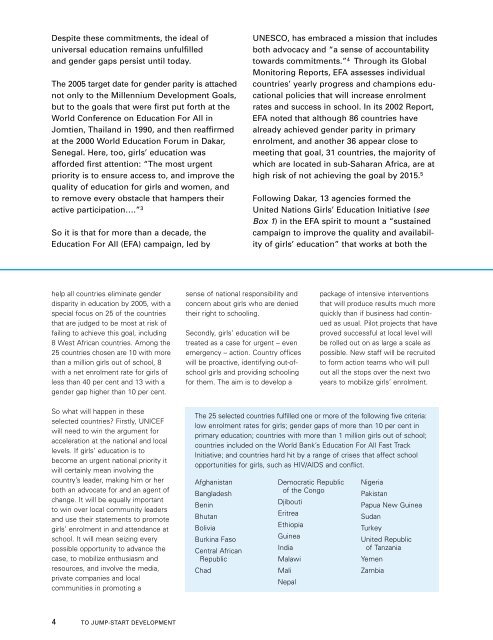THE STATE OF THE WORLD'S CHILDREN 2004 - Unicef
THE STATE OF THE WORLD'S CHILDREN 2004 - Unicef
THE STATE OF THE WORLD'S CHILDREN 2004 - Unicef
You also want an ePaper? Increase the reach of your titles
YUMPU automatically turns print PDFs into web optimized ePapers that Google loves.
Despite these commitments, the ideal of<br />
universal education remains unfulfilled<br />
and gender gaps persist until today.<br />
The 2005 target date for gender parity is attached<br />
not only to the Millennium Development Goals,<br />
but to the goals that were first put forth at the<br />
World Conference on Education For All in<br />
Jomtien, Thailand in 1990, and then reaffirmed<br />
at the 2000 World Education Forum in Dakar,<br />
Senegal. Here, too, girls’ education was<br />
afforded first attention: “The most urgent<br />
priority is to ensure access to, and improve the<br />
quality of education for girls and women, and<br />
to remove every obstacle that hampers their<br />
active participation….” 3<br />
So it is that for more than a decade, the<br />
Education For All (EFA) campaign, led by<br />
UNESCO, has embraced a mission that includes<br />
both advocacy and “a sense of accountability<br />
towards commitments.” 4 Through its Global<br />
Monitoring Reports, EFA assesses individual<br />
countries’ yearly progress and champions educational<br />
policies that will increase enrolment<br />
rates and success in school. In its 2002 Report,<br />
EFA noted that although 86 countries have<br />
already achieved gender parity in primary<br />
enrolment, and another 36 appear close to<br />
meeting that goal, 31 countries, the majority of<br />
which are located in sub-Saharan Africa, are at<br />
high risk of not achieving the goal by 2015. 5<br />
Following Dakar, 13 agencies formed the<br />
United Nations Girls’ Education Initiative (see<br />
Box 1) in the EFA spirit to mount a “sustained<br />
campaign to improve the quality and availability<br />
of girls’ education” that works at both the<br />
help all countries eliminate gender<br />
disparity in education by 2005, with a<br />
special focus on 25 of the countries<br />
that are judged to be most at risk of<br />
failing to achieve this goal, including<br />
8 West African countries. Among the<br />
25 countries chosen are 10 with more<br />
than a million girls out of school, 8<br />
with a net enrolment rate for girls of<br />
less than 40 per cent and 13 with a<br />
gender gap higher than 10 per cent.<br />
sense of national responsibility and<br />
concern about girls who are denied<br />
their right to schooling.<br />
Secondly, girls’ education will be<br />
treated as a case for urgent – even<br />
emergency – action. Country offices<br />
will be proactive, identifying out-ofschool<br />
girls and providing schooling<br />
for them. The aim is to develop a<br />
package of intensive interventions<br />
that will produce results much more<br />
quickly than if business had continued<br />
as usual. Pilot projects that have<br />
proved successful at local level will<br />
be rolled out on as large a scale as<br />
possible. New staff will be recruited<br />
to form action teams who will pull<br />
out all the stops over the next two<br />
years to mobilize girls’ enrolment.<br />
So what will happen in these<br />
selected countries? Firstly, UNICEF<br />
will need to win the argument for<br />
acceleration at the national and local<br />
levels. If girls’ education is to<br />
become an urgent national priority it<br />
will certainly mean involving the<br />
country’s leader, making him or her<br />
both an advocate for and an agent of<br />
change. It will be equally important<br />
to win over local community leaders<br />
and use their statements to promote<br />
girls’ enrolment in and attendance at<br />
school. It will mean seizing every<br />
possible opportunity to advance the<br />
case, to mobilize enthusiasm and<br />
resources, and involve the media,<br />
private companies and local<br />
communities in promoting a<br />
The 25 selected countries fulfilled one or more of the following five criteria:<br />
low enrolment rates for girls; gender gaps of more than 10 per cent in<br />
primary education; countries with more than 1 million girls out of school;<br />
countries included on the World Bank’s Education For All Fast Track<br />
Initiative; and countries hard hit by a range of crises that affect school<br />
opportunities for girls, such as HIV/AIDS and conflict.<br />
Afghanistan<br />
Bangladesh<br />
Benin<br />
Bhutan<br />
Bolivia<br />
Burkina Faso<br />
Central African<br />
Republic<br />
Chad<br />
Democratic Republic<br />
of the Congo<br />
Djibouti<br />
Eritrea<br />
Ethiopia<br />
Guinea<br />
India<br />
Malawi<br />
Mali<br />
Nepal<br />
Nigeria<br />
Pakistan<br />
Papua New Guinea<br />
Sudan<br />
Turkey<br />
United Republic<br />
of Tanzania<br />
Yemen<br />
Zambia<br />
4<br />
TO JUMP-START DEVELOPMENT
















